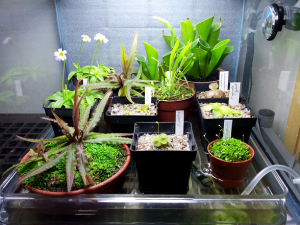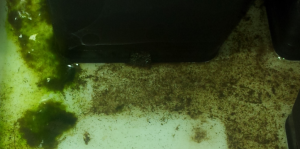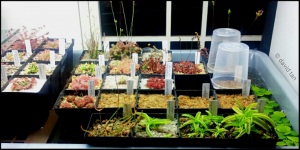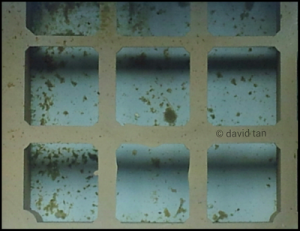PREVENTING ALGAE GROWTH
by David Tan
17 February 2014
![]()
I have always grown carnivorous plants in water trays indoors under lights, probably because I live on the 13th floor in an apartment. One of the things I hate most in my growing area is algae growth in my water trays and plant media. Over the years I have tried a few ways to eliminate or to certain extend reduce algae growth from my growing area.
However, it must be understood that algae is prominent whenever there are bodies of water, in aquatic or terrestrial environments and even on snow or ice.
Preventing Algae Growth on Planting Media
I wash and literary boil all my pots and media with hot water before using and this includes sphagnum moss, perlite, pumice, sand etc, the usual stuff you would use in a CP mix. Sterilizing the media also kills pest and destroy their eggs together with other bad bacteria in the media. It also includes the innocent earth worms. It is important when growing indoors under lights as the plants and media are enclosed in a small area.
If you have sterilized the media properly, you would not have algae growth on the media. However, you must be careful when shifting pots of plants in the tray. Pots carried over other pots that were placed in water trays would drip water on other pots and introduce algae on the media surface if the water is already congested with algae.
Another thing that you can do is to place about 1cm of sand on top the media. This would keep the media surface dry and it would also prevent fungus gnat from laying eggs in the media. The larva loves to eat the tender leaves and roots of some CPs. If you can get your hands on black sand/glass, that would be better. These can be found in aquarium shops and I am not sure if it is broken black glass or a kind or mineral quartz. Water does not stay on this black “sand” as much as normal river sand. However, I have experimented and found that some of the black “sand” is magnetic. Having said this, none of my plants or those of my friend’s plants were affected in growth or health in any way.
Please also note that 1cm of sand does make the surface of the media dry. So humidity around the plants may be lower. However, you can overcome this if your plants are grown in a community tray with the use of an aquarium air pump. Air escaping the water surface from the air stone creates humidity and air flow.
Preventing Algae Growth in Water Trays
Even though CPs are grown in a nutrient free media, decomposing organic matter such as sphagnum moss or sphagnum peat does release some nutrient into the water trays. This always fuel algae growth.
There is a natural way to prevent algae growth completely from my water trays and at the same time remove nutrients and minerals from the water. I have experimented on this for a year now and it really works. However, there is a catch here. You need to sacrifice about 10% of precious space in your water trays for this. But I assure you, the results are good.
Leave a small corner or a small section in the water tray empty. Place floating water plants in that corner and grow them there. Use species like Frogbit, Duckweed, Bayroot, Water Lens, Water Lettuce (Pistia stratiotes) or giant Salvinia (S. molesta) for smaller spaces and Water Hyacinth (Eichhornia crassipes) for large water trays.
These plants have a huge appetite for water and nutrient. After I grew them, I realized I needed to refill water in the trays more often, about once every 2 days whereas in the past I only need to refill once a week.
What these water plants do is to starve the algae of nutrients and they are very effective with that. Usually the algae clear off from my water trays just after a week or less. They turn brown and die.
I like this option as floating water plants also act as filters and the water in my CP trays are clearer and cleaner. In an enclosed space minerals do build up over time. Their roots naturally absorb minerals and pollutants including lead, mercury etc and this go well with CPs. Some countries use Water Hyacinth as natural filters for waste water treatment. They are that effective! They have the ability to rapidly multiply and develop strong trailing root system and can withstand extremes temperatures, nutrients, pH levels and even toxic water. Sometimes I am amazed at how far their roots crawl all over my trays and into my CP pots.
Happy growing! ![]()






